Environmental Science Project: Kaibab Plateau Deer Herd Management
VerifiedAdded on 2023/05/29
|7
|1225
|122
Project
AI Summary
This project analyzes the Kaibab Plateau deer herd in Northern Arizona, examining its population dynamics from 1905 to 1939. The study explores the impact of wildlife management practices, including hunting bans and predator control, on the deer population. The project presents data on the deer population over time, illustrating fluctuations and the influence of factors like carrying capacity, overgrazing, and natural occurrences such as winter. The analysis highlights lessons learned from this case study, emphasizing the importance of maintaining populations within ecosystem carrying capacities and recognizing the role of predators. The Kaibab plateau serves as an example of how environmental factors and human intervention can significantly impact wildlife populations, with implications for conservation efforts and sustainable management strategies. The project also highlights the importance of adapting management policies to local conditions and acknowledging the influence of natural occurrences.
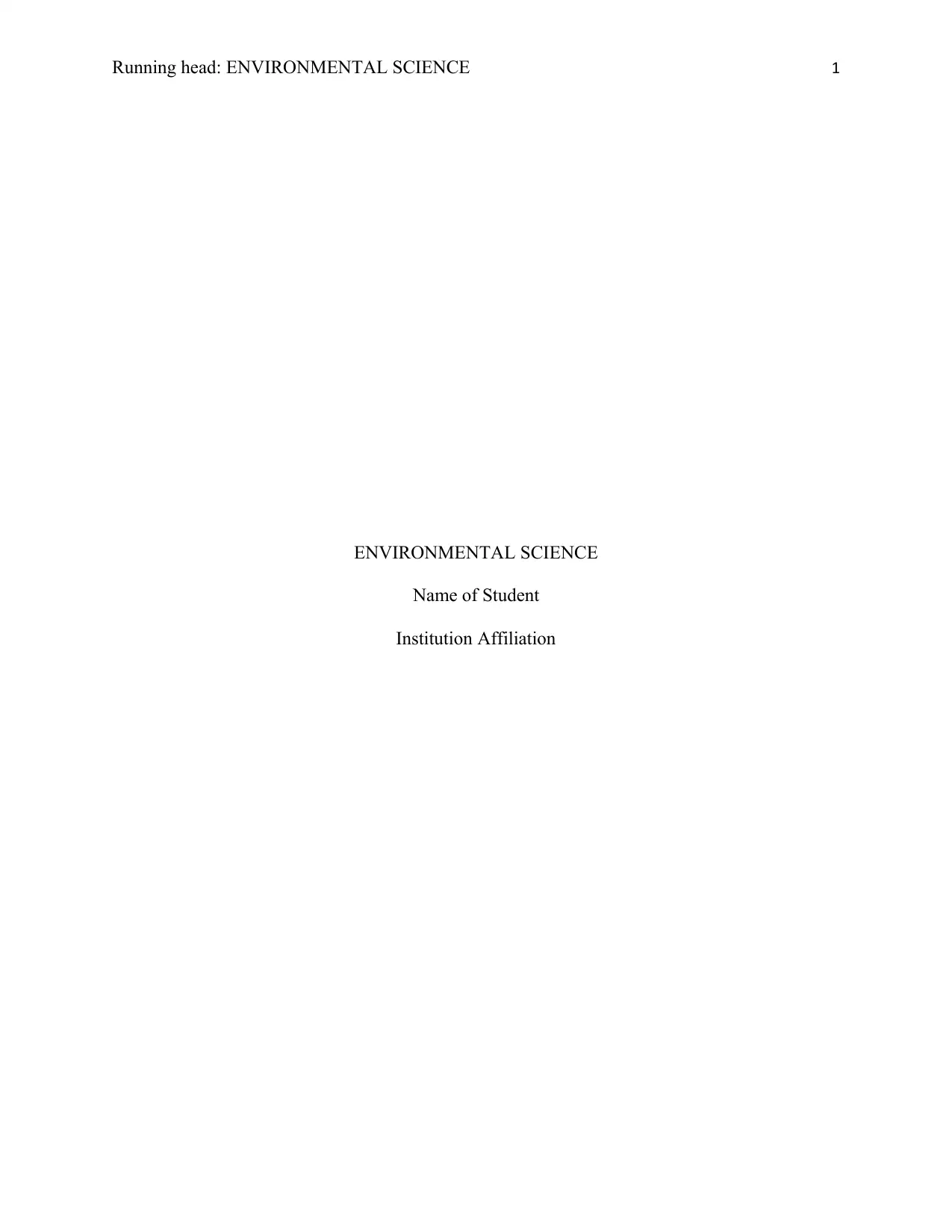
Running head: ENVIRONMENTAL SCIENCE 1
ENVIRONMENTAL SCIENCE
Name of Student
Institution Affiliation
ENVIRONMENTAL SCIENCE
Name of Student
Institution Affiliation
Paraphrase This Document
Need a fresh take? Get an instant paraphrase of this document with our AI Paraphraser
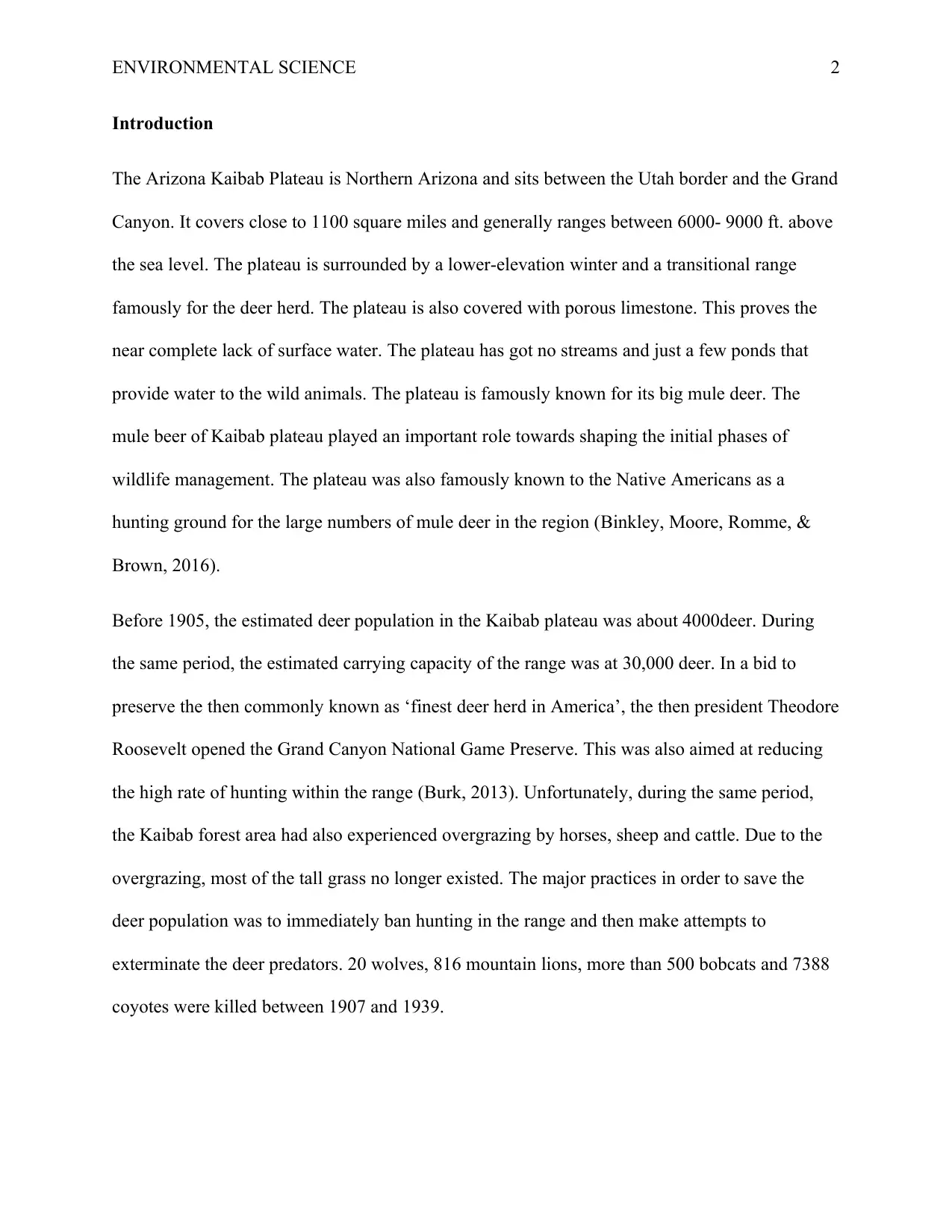
ENVIRONMENTAL SCIENCE 2
Introduction
The Arizona Kaibab Plateau is Northern Arizona and sits between the Utah border and the Grand
Canyon. It covers close to 1100 square miles and generally ranges between 6000- 9000 ft. above
the sea level. The plateau is surrounded by a lower-elevation winter and a transitional range
famously for the deer herd. The plateau is also covered with porous limestone. This proves the
near complete lack of surface water. The plateau has got no streams and just a few ponds that
provide water to the wild animals. The plateau is famously known for its big mule deer. The
mule beer of Kaibab plateau played an important role towards shaping the initial phases of
wildlife management. The plateau was also famously known to the Native Americans as a
hunting ground for the large numbers of mule deer in the region (Binkley, Moore, Romme, &
Brown, 2016).
Before 1905, the estimated deer population in the Kaibab plateau was about 4000deer. During
the same period, the estimated carrying capacity of the range was at 30,000 deer. In a bid to
preserve the then commonly known as ‘finest deer herd in America’, the then president Theodore
Roosevelt opened the Grand Canyon National Game Preserve. This was also aimed at reducing
the high rate of hunting within the range (Burk, 2013). Unfortunately, during the same period,
the Kaibab forest area had also experienced overgrazing by horses, sheep and cattle. Due to the
overgrazing, most of the tall grass no longer existed. The major practices in order to save the
deer population was to immediately ban hunting in the range and then make attempts to
exterminate the deer predators. 20 wolves, 816 mountain lions, more than 500 bobcats and 7388
coyotes were killed between 1907 and 1939.
Introduction
The Arizona Kaibab Plateau is Northern Arizona and sits between the Utah border and the Grand
Canyon. It covers close to 1100 square miles and generally ranges between 6000- 9000 ft. above
the sea level. The plateau is surrounded by a lower-elevation winter and a transitional range
famously for the deer herd. The plateau is also covered with porous limestone. This proves the
near complete lack of surface water. The plateau has got no streams and just a few ponds that
provide water to the wild animals. The plateau is famously known for its big mule deer. The
mule beer of Kaibab plateau played an important role towards shaping the initial phases of
wildlife management. The plateau was also famously known to the Native Americans as a
hunting ground for the large numbers of mule deer in the region (Binkley, Moore, Romme, &
Brown, 2016).
Before 1905, the estimated deer population in the Kaibab plateau was about 4000deer. During
the same period, the estimated carrying capacity of the range was at 30,000 deer. In a bid to
preserve the then commonly known as ‘finest deer herd in America’, the then president Theodore
Roosevelt opened the Grand Canyon National Game Preserve. This was also aimed at reducing
the high rate of hunting within the range (Burk, 2013). Unfortunately, during the same period,
the Kaibab forest area had also experienced overgrazing by horses, sheep and cattle. Due to the
overgrazing, most of the tall grass no longer existed. The major practices in order to save the
deer population was to immediately ban hunting in the range and then make attempts to
exterminate the deer predators. 20 wolves, 816 mountain lions, more than 500 bobcats and 7388
coyotes were killed between 1907 and 1939.
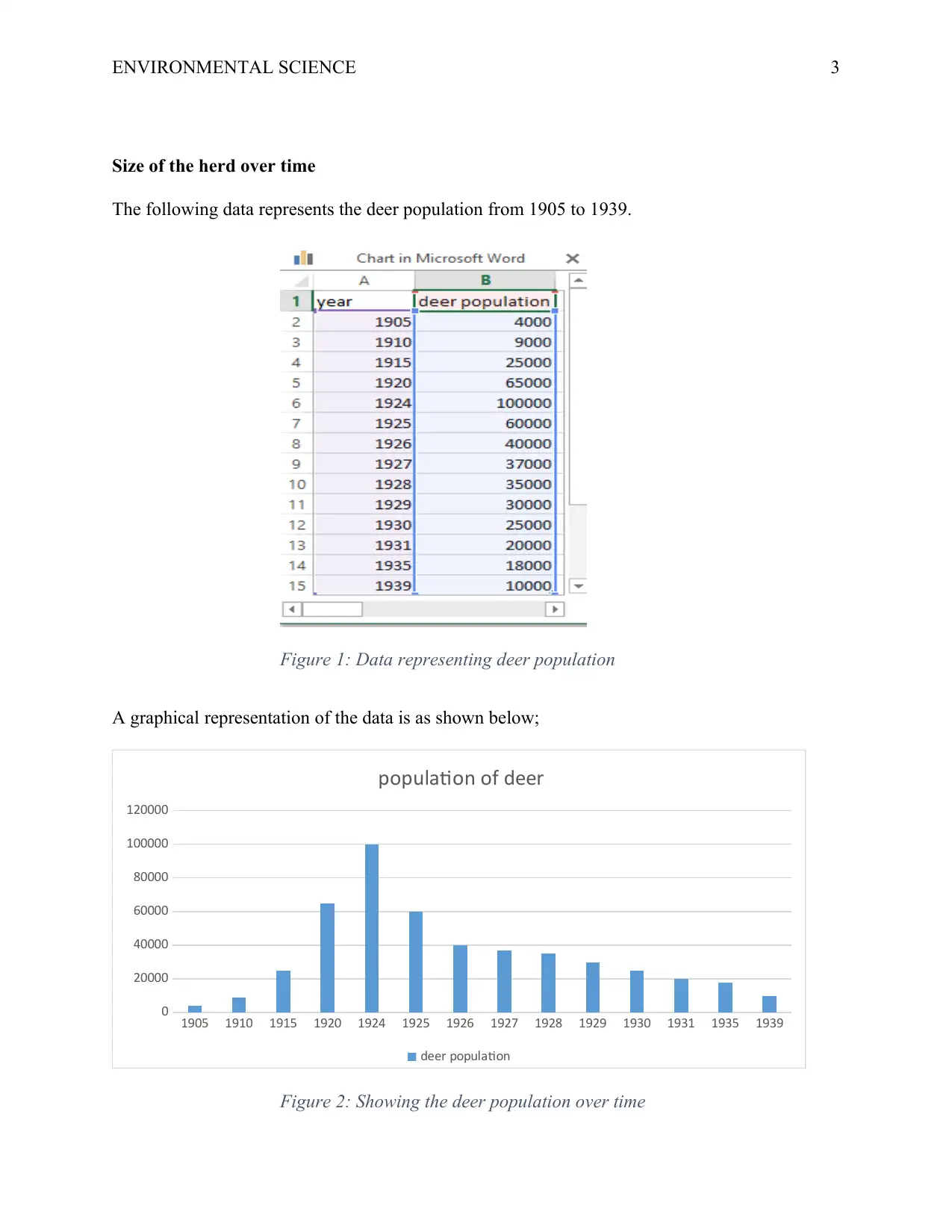
ENVIRONMENTAL SCIENCE 3
Size of the herd over time
The following data represents the deer population from 1905 to 1939.
Figure 1: Data representing deer population
A graphical representation of the data is as shown below;
1905 1910 1915 1920 1924 1925 1926 1927 1928 1929 1930 1931 1935 1939
0
20000
40000
60000
80000
100000
120000
population of deer
deer population
Figure 2: Showing the deer population over time
Size of the herd over time
The following data represents the deer population from 1905 to 1939.
Figure 1: Data representing deer population
A graphical representation of the data is as shown below;
1905 1910 1915 1920 1924 1925 1926 1927 1928 1929 1930 1931 1935 1939
0
20000
40000
60000
80000
100000
120000
population of deer
deer population
Figure 2: Showing the deer population over time
⊘ This is a preview!⊘
Do you want full access?
Subscribe today to unlock all pages.

Trusted by 1+ million students worldwide
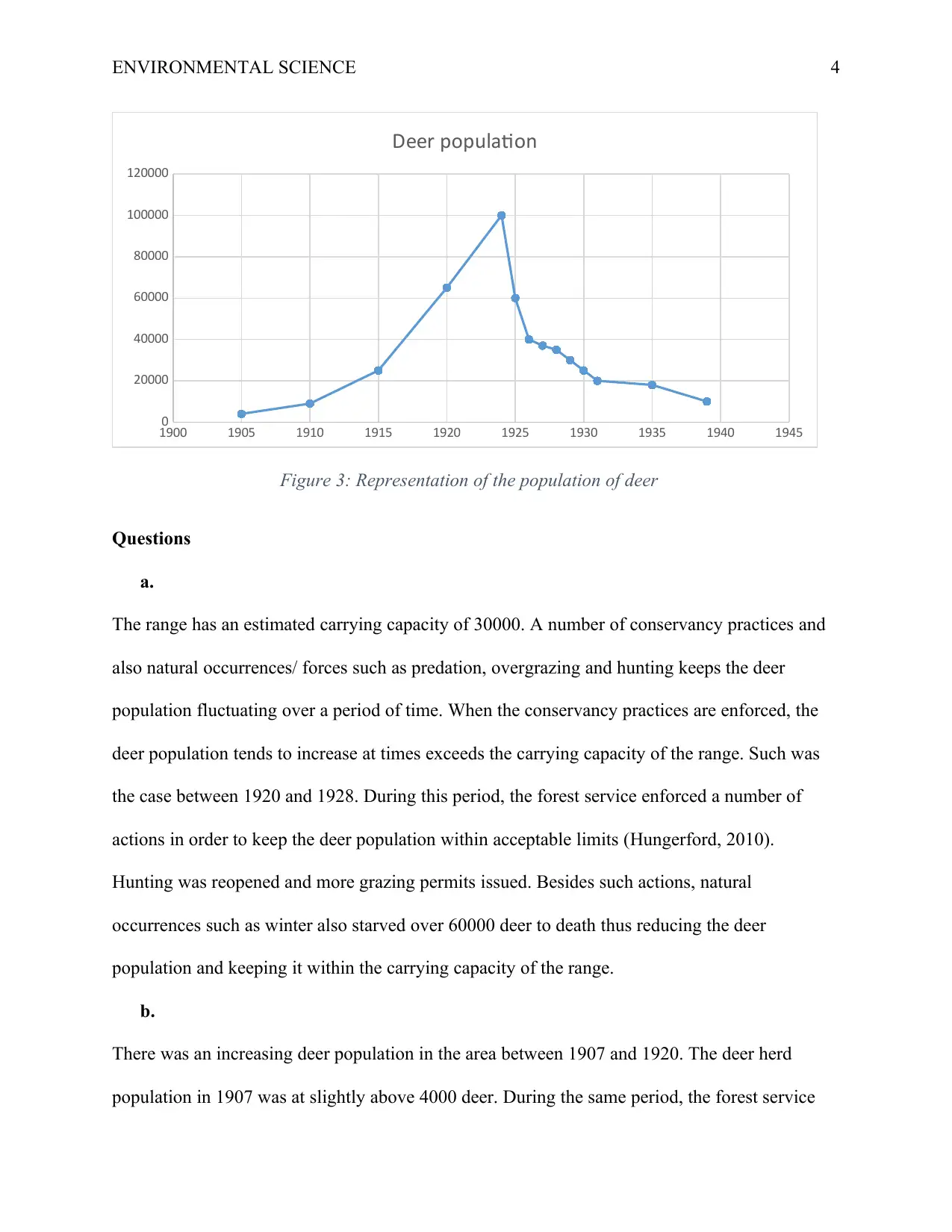
ENVIRONMENTAL SCIENCE 4
1900 1905 1910 1915 1920 1925 1930 1935 1940 1945
0
20000
40000
60000
80000
100000
120000
Deer population
Figure 3: Representation of the population of deer
Questions
a.
The range has an estimated carrying capacity of 30000. A number of conservancy practices and
also natural occurrences/ forces such as predation, overgrazing and hunting keeps the deer
population fluctuating over a period of time. When the conservancy practices are enforced, the
deer population tends to increase at times exceeds the carrying capacity of the range. Such was
the case between 1920 and 1928. During this period, the forest service enforced a number of
actions in order to keep the deer population within acceptable limits (Hungerford, 2010).
Hunting was reopened and more grazing permits issued. Besides such actions, natural
occurrences such as winter also starved over 60000 deer to death thus reducing the deer
population and keeping it within the carrying capacity of the range.
b.
There was an increasing deer population in the area between 1907 and 1920. The deer herd
population in 1907 was at slightly above 4000 deer. During the same period, the forest service
1900 1905 1910 1915 1920 1925 1930 1935 1940 1945
0
20000
40000
60000
80000
100000
120000
Deer population
Figure 3: Representation of the population of deer
Questions
a.
The range has an estimated carrying capacity of 30000. A number of conservancy practices and
also natural occurrences/ forces such as predation, overgrazing and hunting keeps the deer
population fluctuating over a period of time. When the conservancy practices are enforced, the
deer population tends to increase at times exceeds the carrying capacity of the range. Such was
the case between 1920 and 1928. During this period, the forest service enforced a number of
actions in order to keep the deer population within acceptable limits (Hungerford, 2010).
Hunting was reopened and more grazing permits issued. Besides such actions, natural
occurrences such as winter also starved over 60000 deer to death thus reducing the deer
population and keeping it within the carrying capacity of the range.
b.
There was an increasing deer population in the area between 1907 and 1920. The deer herd
population in 1907 was at slightly above 4000 deer. During the same period, the forest service
Paraphrase This Document
Need a fresh take? Get an instant paraphrase of this document with our AI Paraphraser
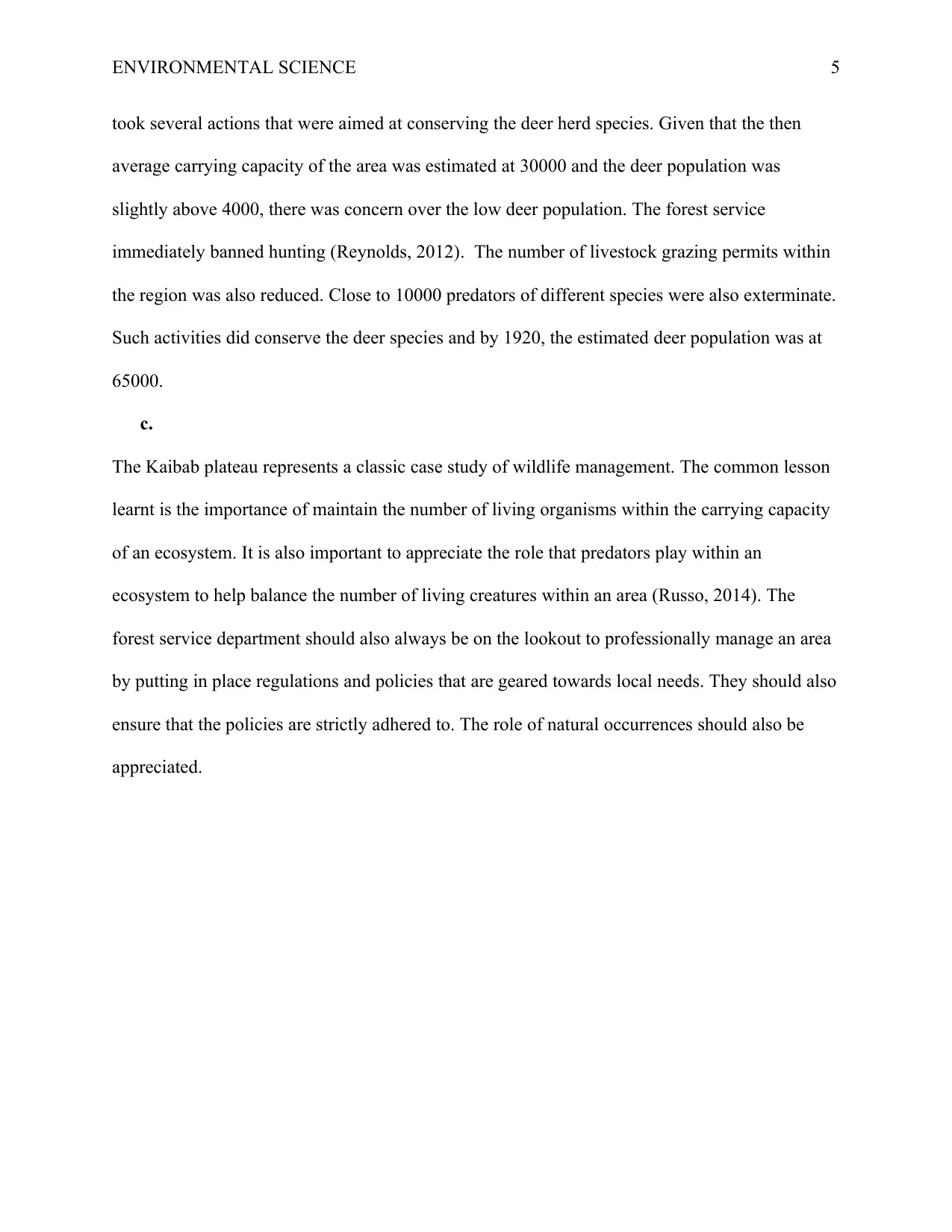
ENVIRONMENTAL SCIENCE 5
took several actions that were aimed at conserving the deer herd species. Given that the then
average carrying capacity of the area was estimated at 30000 and the deer population was
slightly above 4000, there was concern over the low deer population. The forest service
immediately banned hunting (Reynolds, 2012). The number of livestock grazing permits within
the region was also reduced. Close to 10000 predators of different species were also exterminate.
Such activities did conserve the deer species and by 1920, the estimated deer population was at
65000.
c.
The Kaibab plateau represents a classic case study of wildlife management. The common lesson
learnt is the importance of maintain the number of living organisms within the carrying capacity
of an ecosystem. It is also important to appreciate the role that predators play within an
ecosystem to help balance the number of living creatures within an area (Russo, 2014). The
forest service department should also always be on the lookout to professionally manage an area
by putting in place regulations and policies that are geared towards local needs. They should also
ensure that the policies are strictly adhered to. The role of natural occurrences should also be
appreciated.
took several actions that were aimed at conserving the deer herd species. Given that the then
average carrying capacity of the area was estimated at 30000 and the deer population was
slightly above 4000, there was concern over the low deer population. The forest service
immediately banned hunting (Reynolds, 2012). The number of livestock grazing permits within
the region was also reduced. Close to 10000 predators of different species were also exterminate.
Such activities did conserve the deer species and by 1920, the estimated deer population was at
65000.
c.
The Kaibab plateau represents a classic case study of wildlife management. The common lesson
learnt is the importance of maintain the number of living organisms within the carrying capacity
of an ecosystem. It is also important to appreciate the role that predators play within an
ecosystem to help balance the number of living creatures within an area (Russo, 2014). The
forest service department should also always be on the lookout to professionally manage an area
by putting in place regulations and policies that are geared towards local needs. They should also
ensure that the policies are strictly adhered to. The role of natural occurrences should also be
appreciated.
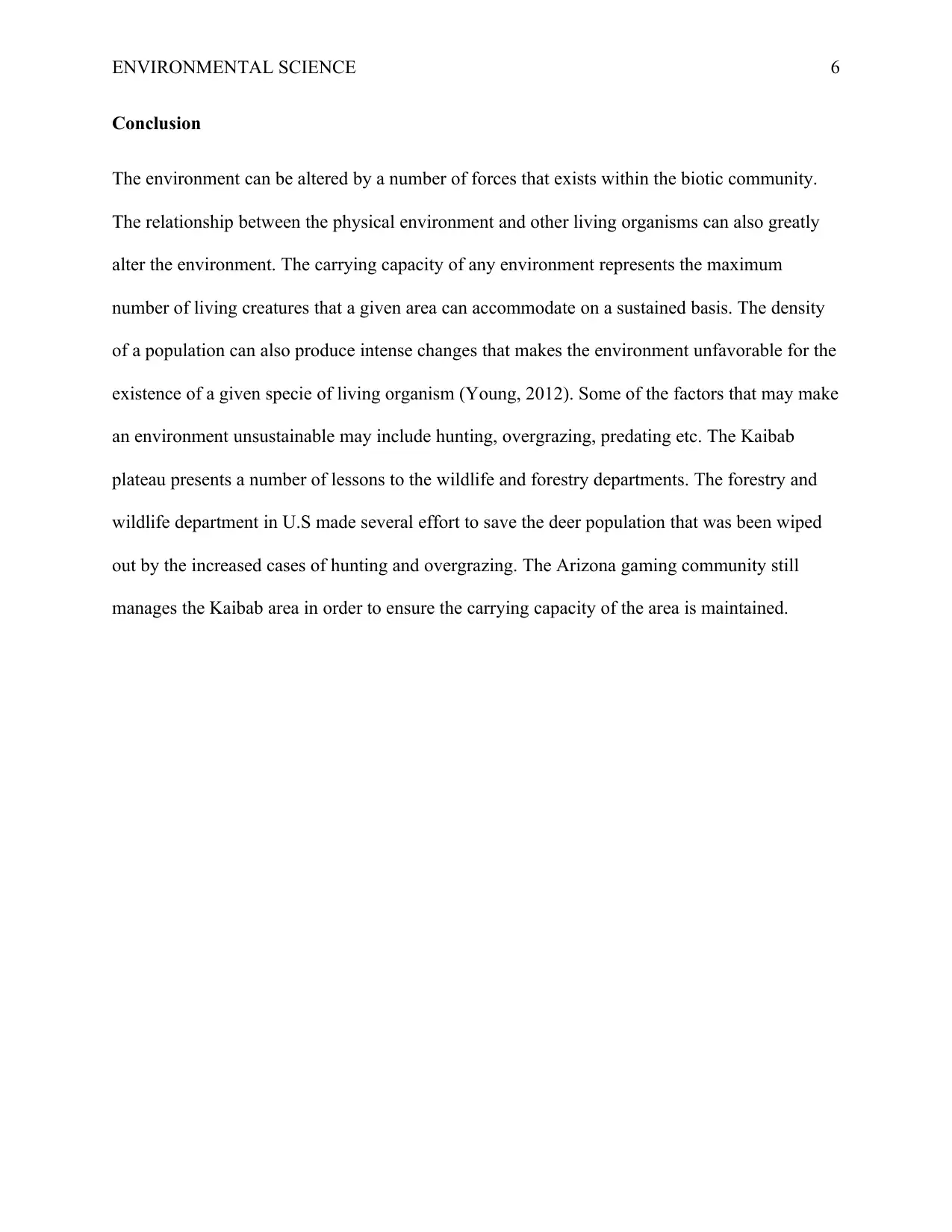
ENVIRONMENTAL SCIENCE 6
Conclusion
The environment can be altered by a number of forces that exists within the biotic community.
The relationship between the physical environment and other living organisms can also greatly
alter the environment. The carrying capacity of any environment represents the maximum
number of living creatures that a given area can accommodate on a sustained basis. The density
of a population can also produce intense changes that makes the environment unfavorable for the
existence of a given specie of living organism (Young, 2012). Some of the factors that may make
an environment unsustainable may include hunting, overgrazing, predating etc. The Kaibab
plateau presents a number of lessons to the wildlife and forestry departments. The forestry and
wildlife department in U.S made several effort to save the deer population that was been wiped
out by the increased cases of hunting and overgrazing. The Arizona gaming community still
manages the Kaibab area in order to ensure the carrying capacity of the area is maintained.
Conclusion
The environment can be altered by a number of forces that exists within the biotic community.
The relationship between the physical environment and other living organisms can also greatly
alter the environment. The carrying capacity of any environment represents the maximum
number of living creatures that a given area can accommodate on a sustained basis. The density
of a population can also produce intense changes that makes the environment unfavorable for the
existence of a given specie of living organism (Young, 2012). Some of the factors that may make
an environment unsustainable may include hunting, overgrazing, predating etc. The Kaibab
plateau presents a number of lessons to the wildlife and forestry departments. The forestry and
wildlife department in U.S made several effort to save the deer population that was been wiped
out by the increased cases of hunting and overgrazing. The Arizona gaming community still
manages the Kaibab area in order to ensure the carrying capacity of the area is maintained.
⊘ This is a preview!⊘
Do you want full access?
Subscribe today to unlock all pages.

Trusted by 1+ million students worldwide
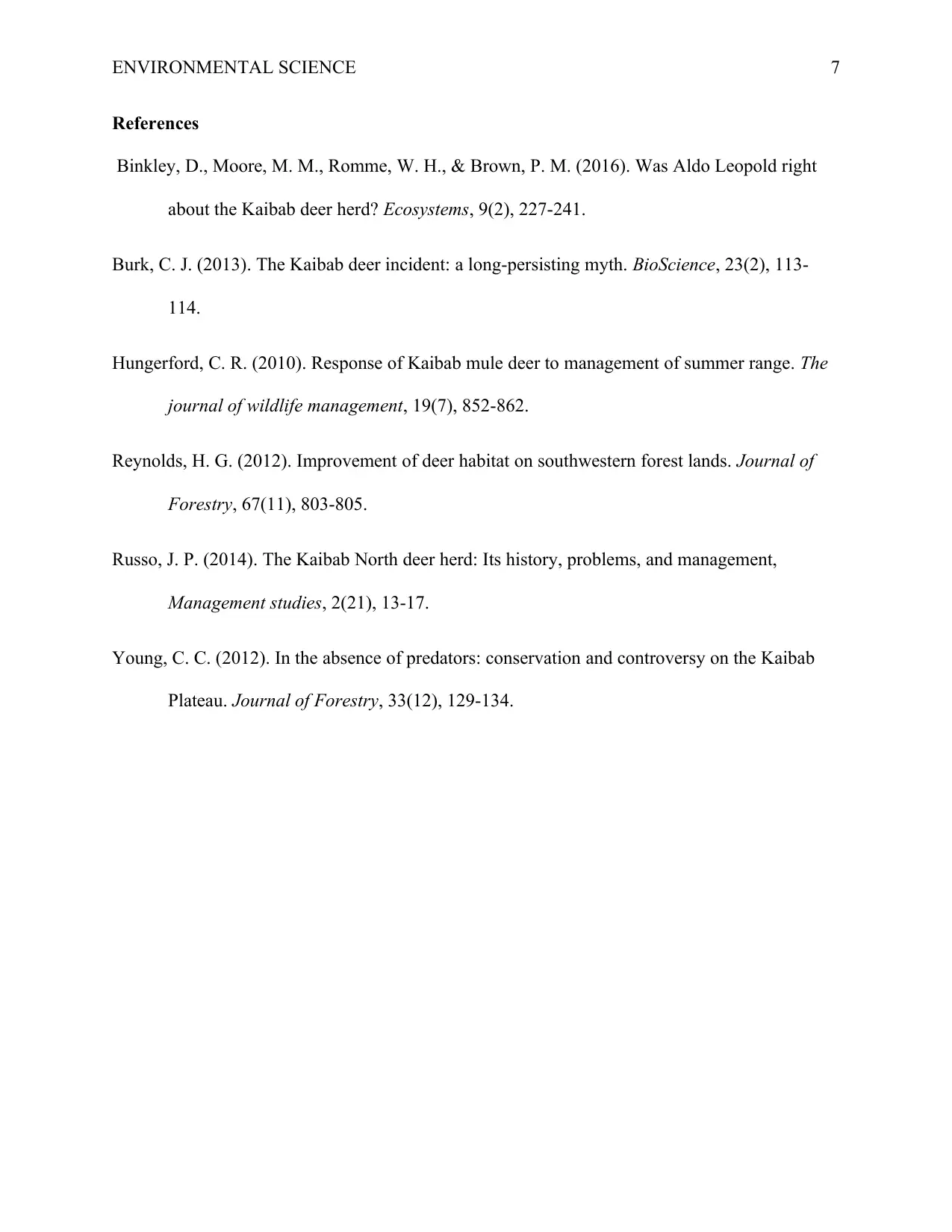
ENVIRONMENTAL SCIENCE 7
References
Binkley, D., Moore, M. M., Romme, W. H., & Brown, P. M. (2016). Was Aldo Leopold right
about the Kaibab deer herd? Ecosystems, 9(2), 227-241.
Burk, C. J. (2013). The Kaibab deer incident: a long-persisting myth. BioScience, 23(2), 113-
114.
Hungerford, C. R. (2010). Response of Kaibab mule deer to management of summer range. The
journal of wildlife management, 19(7), 852-862.
Reynolds, H. G. (2012). Improvement of deer habitat on southwestern forest lands. Journal of
Forestry, 67(11), 803-805.
Russo, J. P. (2014). The Kaibab North deer herd: Its history, problems, and management,
Management studies, 2(21), 13-17.
Young, C. C. (2012). In the absence of predators: conservation and controversy on the Kaibab
Plateau. Journal of Forestry, 33(12), 129-134.
References
Binkley, D., Moore, M. M., Romme, W. H., & Brown, P. M. (2016). Was Aldo Leopold right
about the Kaibab deer herd? Ecosystems, 9(2), 227-241.
Burk, C. J. (2013). The Kaibab deer incident: a long-persisting myth. BioScience, 23(2), 113-
114.
Hungerford, C. R. (2010). Response of Kaibab mule deer to management of summer range. The
journal of wildlife management, 19(7), 852-862.
Reynolds, H. G. (2012). Improvement of deer habitat on southwestern forest lands. Journal of
Forestry, 67(11), 803-805.
Russo, J. P. (2014). The Kaibab North deer herd: Its history, problems, and management,
Management studies, 2(21), 13-17.
Young, C. C. (2012). In the absence of predators: conservation and controversy on the Kaibab
Plateau. Journal of Forestry, 33(12), 129-134.
1 out of 7
Your All-in-One AI-Powered Toolkit for Academic Success.
+13062052269
info@desklib.com
Available 24*7 on WhatsApp / Email
![[object Object]](/_next/static/media/star-bottom.7253800d.svg)
Unlock your academic potential
Copyright © 2020–2025 A2Z Services. All Rights Reserved. Developed and managed by ZUCOL.